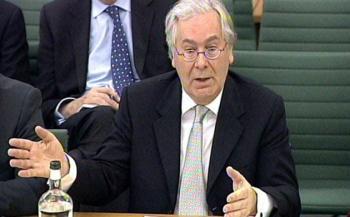- Caroline Criado-Perez
On this auspicious day in 2013, Mervyn King, our esteemed Governor of that august institution, the Bank of England, graced the airwaves via the Murnaghan Show

Mervyn Explains
on Sky News, to make his first public comment about the banknotes petition. Mervyn took the opportunity to explain how the process worked, stressed that everyone is treated fairly, and finally, as his pièce de résistance, explained that since the Queen is on the banknotes anyway, we should all give over really.
Now, Mervyn is by far not the first man to explain banknotes to me - indeed, in some ways I’m disappointed it took him so long. Poor show, Merv.
But in other ways, I’m not so much disappointed as furious. You see, Mervyn King is not really like the long list of men who thought that we must have missed the fact that the Queen is on all the banknotes, and took it upon themselves to explain to us. I am used to men explaining things to me before checking – for example by reading the petition text - whether or not I may in fact already have this information at my disposal. I laugh at them.
But Merv’s different. You see, as Governor of the Bank of England, the petition is directed at Mervyn. So really, he should have read it. And the fact that he clearly hasn’t, despite the fact that over 24000 people have signed it, and that his decision has been deemed to have breached the 2010 Equality Act, demonstrates the disdain he holds for the signatories of the petition, for the Equality Act, and for equality itself.
You see Mervyn, as I explained in my petition, should you care to read it, we actually know about the Queen. But we’ve got a few problems with her being handed to us as a booby prize. You see Merv, and stop me if you already know this, the Queen isn’t really on the banknotes by virtue of her good works. She could have done absolutely nothing all her life and she would still be there, because, you see, the Queen is on the banknotes by virtue of her position, which she achieved through a grand old tradition called birthright. The Queen isn’t on the banknotes; the monarch is. And the monarch could be anyone – indeed, the monarch soon will be a man. Where will your non-argument be then, Mervyn?
Chris Salmon, the Executive Director of Banking and Chief Cashier of the Bank himself acknowledges that ‘The Bank is uniquely privileged to be able to use its banknotes to promote awareness and understanding of the contribution of key figures from our past to our cultural, artistic and scientific legacy’. So what message does it send out when all the people who fill that role are men, and the one woman is there by birthright? Let me explain, Mervyn: it sends out the message that women had better be born into, or at a stretch, marry into power – they aren’t managing to contribute in any other way.
What is particularly galling about the rest of Mervyn’s argument, is the idea that because the public can write into a list, this decision is somehow fair and transparent, and women are treated equally. This claim is farcical.
To adress the list itself, there is no denying that it is poor, and represents a damning indictment of the androcentricity of our curriculum – something that is only set to get worse, thanks to Mr Gove, another modern champion of equality. Nevertheless, it does contain some stand-out figures such as Rosalind Franklin, Mary Seacole and Jane Austen. But apparently, Churchill ‘easily clears’ this ‘high hurdle‘ of having ’made a lasting contribution which…has had enduring benefits’ ahead of any of them. No explanation is given of how this decision was reached, of why Churchill’s achievements are so great that they deserve to be recognised not only ahead of someone who was instrumental in discovering the DNA double helix (pretty useful that), but that they deserve to wipe out any recognition of any woman at all.
The Bank of England actually states that they view the opportunity to change banknotes as ‘a chance to review whether the set of characters for the four denominations achieves a balance over a range of different types of contributions and across different fields’. This means that they sat down and considered whether the four denominations as a whole represented ‘balance’, before deciding that, not only should another man’s name should be chosen over a woman, but that this man should replace the only woman we have on there, representing an actual backwards step for equality. Let me repeat that: they considered the four denominations together, in search of ‘balance’, and saw no problem with excluding women entirely from a ‘gilded list of the most distinguished names from other fields of human endeavour’.
If this is equality, you can stick it.
